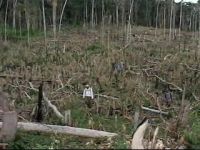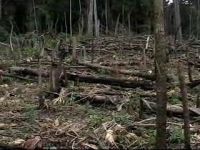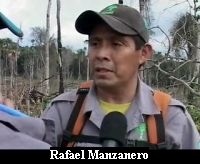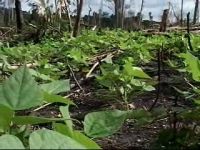

And from Pilar to the Chiquibul National Park, which is the largest protected area in Belize covering more than 264,000 acres – which includes the
Caracol Archeological Reserve. That vast area is resource rich and it borders areas of Guatemala that have been stripped of all their timber, and
agricultural lands. In short, it is a green forest of plenty jammed right up against, brown lands that have been flattened by years of agricultural
over use. The people who occupy those lands in villages like Monte Los Olivos are poor and in their search for land they come to Belize. We found one
such spot in 2009 – and we reprise that story from our archives….
Lt. Justo Velez, Commanding Officer
"So we come down this track which will actually lead us to the farm."
That square is the mission point, a Guatemalan farm in Belizean territory. Speaking in a barely audible whisper Lt. Velez outlined the plan to his soldiers
for what's known as a close target reconnaissance meaning these soldiers and the police officer will go ahead and scope out the area at close range to see
if anyone is there and if they are armed.
The seven soldiers who stayed with us wait for word back from the reconnaissance group and finally we get the signal we can proceed the 50 meters to the
site, a cleared area – no hostiles have been detected. What we find is literally a disgrace, a slice at the western edge of a Belizean protected area, the
Caracol Archaeological Reserve burnt down and cleared slashed and burnt for Guatemalan milperos.
 Rafael Manzanero, Friends for Conservation and Development
Rafael Manzanero, Friends for Conservation and Development
"What we're seeing in terms of landscape here is within the Caracal Archaeological Reserve. Of course as a result then we can imagine that it would be
a nice virgin forest with standing trees but what you can see here is certainly, they have already removed the forest cover, the trees have already
been burnt and then they have already planted.Our rules, our regulations, our laws are stating that any of this thing is really illegal to do. So then
the question of Guatemalans shouldn't being able to do it then certainly it prompts another series of questions of course."

They grow all the milpa staples here pumpkin – these ones have been dried for pepitos while this one is still on the root. There's also beans. But it's
Corn that dominates the field; it is everywhere – the cornstalks have been left to dry – dried corn is like currency in Peten Guatemala and this field is
full of it. And there are also these sacks covered by a tarp ready to go to market. This corn will be used to make tortillas or as animal feed. And it is
only dry corns, new shoots of corn have also been planted – those are everywhere too – and in an act of futile desperation the group from the FCD uproots
some of the shoot.
Rafael Manzanero
"So how much would it require to come in and destroy all of this, well it requires multiple days to be here on the spot and ensuring there is safety
for the people who are doing it as well."
Dr. Colin Young
"This is a classic case where I think the instinct is certainly not the most practical and that is obviously to come in here and destroy all of them.
But because of the sensitive nature of where this place is, so close to the border, within the adjacency zone, I think it requires the sort of
multi-sectoral approach, sort of a task force. We kind of have them but the process, the wheels turn quite slowly and in the process we are losing the
forest on this side of the border incredibly fast."
Indeed, the area is immense – we are dwarfed by the size of it.
Rafael Manzanero
"What I see there as well you saw is that the cornfield is measured 800 meters by 300 metres extending southward by the grid along the map. And
presently the corn is not being extracted, yet they are already replanting the whole farm and in the farm as normal as what we always find, they have
pumpkin, beans, and the corn that they just planted."
Dr. Colin Young
"You look at this place, this is a couple hectares of land cleared, active, fresh plants, incredibly frustrating Jules."
And more so on this day because we had to leave it all behind – mostly intact – all we had to take was Beningo Garcia the hapless hunter caught with a pair
of gibnut, a rifle and machete and live rounds. The truth is while he was caught red handed – he's just another poor Guatemalan looking to the green
resource rich lands of Belize for a means of survival. The symptom may be poaching but the problem is poverty:
Dr. Colin Young
"When we look at the reality on the ground in like Guatemala, we have a population that is incredibly poor and as long as that remains the case, the
pull for them to come into this side will be great and any solution will have to involve a kind of relationship with the Guatemalans on that so that
they could create the kind of alternative livelihood opportunities for them on that side so as to not create the kind of push factor that brings them
into Belize. If we don't deal with the poverty there and the fact that they don't have the green land then these looks like a garden of Eden to them."
A garden of Eden or a paradise at risk of being lost to these silent invaders I'll draw some conclusions about the future of this park in peril.
Again, that report was from 2009. But up to 2014 – it's only gotten worse and Guatemalan plantations continue to be found in Chiquibul. Earlier this
year, a total of 25 fields covering 125 acres were discovered and destroyed. They contained pumpkin, corn, beans, sweet potatoes, cassava, plantain,
and bananas.
Various reporters from the 7News team have been into the far reaches of Chiquibul in the past five years – and all this week we'll be reprising select
stories.
7 News for October 1st, 2014 from 7News Belize on Vimeo.



